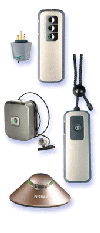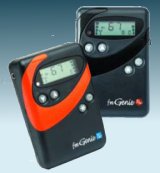Wednesday, May 24, 2006
O.T
erick and i were asked by our manager if we want to commit ourselves to 6 months overtime. it's not a lot really as it's only once a week, for about 3 hours with 1 1/2 pay. not bad, that would help cover some 'holiday' costs. *lol*
it would, however, be in lymington hospital (45minutes from our main office, 30minutes from home). we'll do it on a monday. so i'll be coming from hythe (another outstation) with 30minutes travel time. i'll be hitching a ride home with erick. i'll probably be home around 9:30pm.
is it all worth it? considering taxes, travel, time? we'll see....
Posted by QT at 5/24/2006 09:14:00 am
Wednesday, May 17, 2006
NAL-NL1
this is the fitting method we are using in the department. it stands for national acoustics labs, non-linear, version 1.
The NAL-NL1 fitting procedure aims to provide the gain-frequency response that maximizes speech intelligibility while keeping overall loudness at a level no greater than that perceived by a normal-hearing person listening to the same sound. The calculations of speech intelligibility are based on extensive NAL research into how audibility relates to intelligibility. (NAL)
i must have been zzzzz-ing again when this was discussed in class *lol*
coming to england, i was bombarded with a lot of hearing aid stuff which i was so scared to tackle back in pinas. mahal kasi ng hearing aids dun so i'd rather not mess with it - ala pa naman akong pambayad pag nasira ko un (i would need my whole year salary in pinas to pay for a digital one!). grabe noh!
anyways, coming to england made me forget (little by little) most of the stuff i love doing - objective assessments (abr, eng). pano nd masyado napa-practise dito. hmmph! not to worry naman, i would only need to read up and update myself with what's new so i don't get left behind. and on the bright side, our department does all those objective assessments naman and they are using the same equipments we have back in pinas. so i just need to bid my time. hihihi!
come to think of it, i am now equipped with more knowledge (and skills) than i would have hoped for (rather, more than what my small brain could have absorbed =p).
this blog should be about nal-nl1 so, for more information, click here.
other fitting rationales can be found here (am not promoting bernafon, though. self explanatory ksi ung descriptions nila =p)
Posted by QT at 5/17/2006 10:51:00 am
Sunday, May 14, 2006
REMs
 or real ear measurements..
or real ear measurements..it's a standard procedure in our department to ensure optimal fitting of hearing aids to prescription targets based on the program set by MHAS (Modernising Hearing Aid Services).
i honestly did not know much about it (i was probably Zzzzzz-ing during lectures! =p) till i came here in uk to work. i think it's more because we didn't get to fit much aids in pinas. most of the patients that came my way were for diagnosis and when they needed rehabilitation, they're passed on to my colleague (and good friend) hubert up at the centre for audiological sciences.
i also blame it on the fact that hearing aid fits (esp. digital aids) were scarce as there are only a handful who can afford them. man, they're expensive! also, the probe tips that we used during practicals were so thick, i wouldn't have them inserted in my own ears! just so scared im gonna bust the pt's. tm with it.
but coming here, i was 'forced' to learn it by heart (have i?). i can certainly do it with eyes closed (well..just an exaggeration *lol*). anyways, what is it really and why do we have to do it?
What?
REMs allow your audiologist to evaluate the function of your hearing aids while you are wearing them. This evaluation guides your audiologist in making the necessary adjustments to assure optimal amplification.The shapes and sizes of everyone's ears, ear canals and head are quite different, and the degree and type of hearing loss varies from individual to individual. As a result, identical hearing aids may function quite differently in one person's ear than on another person's ear.
How?
To perform REM, your audiologist will place a tiny microphone into your ear canal. Sounds are then presented to the open ear to measure the effects of your open ear canal on the sound. Your hearing aid is then inserted and measures are made of the same exact sound in your ear canal with the aid in place. The difference between the two measurements is called the real-ear insertion gain of your hearing aid. It tells your audiologist a great deal about the quality of the sound you are receiving.
Once the real-ear insertion gain of your hearing aid is known, it can be compared to widely used amplification prescriptions, such as the National Acoustic Laboratories-Revised (NAL-R) prescription, the Libby prescription, or the Prescription of Gain and Output (POGO). ****In our case, we use NAL-NL1****
Why?
If there are differences in the prescribed sound quality and the measured sound of the aid, your audiologist can make necessary adjustments and take new measurements to fine-tune your hearing aid to provide the best possible sound, and therefore, the most possible benefit.
from: ACA (audiological consultants of atlanta)
a more detailed explanation of REMs can be found here
so, whatdyathink? =p
Posted by QT at 5/14/2006 02:16:00 pm
Wednesday, May 10, 2006
Radio Aids
 A radio hearing aid effectively 'reduces' the distance between the speaker and the deaf child, whether that speaker is a parent, teacher or anyone in communication with the child. In the usual post-aural hearing aid the microphone is close to the ear of the person wearing the aid. As we have said, this microphone picks up and amplifies all background noise as well as speech. It cannot discriminate between the two. The microphone on a post aural hearing aid becomes less and less effective as the distance between the speaker and the child increases.
A radio hearing aid effectively 'reduces' the distance between the speaker and the deaf child, whether that speaker is a parent, teacher or anyone in communication with the child. In the usual post-aural hearing aid the microphone is close to the ear of the person wearing the aid. As we have said, this microphone picks up and amplifies all background noise as well as speech. It cannot discriminate between the two. The microphone on a post aural hearing aid becomes less and less effective as the distance between the speaker and the child increases. In a radio aid the microphone is separated from the hearing aid and given to the speaker. The subsequent link between the microphone and the receiver on the child's ear is via radio waves.This means that the distance between the spoken word and the microphone is close and constant and there is less opportunity for background noise to be picked and therefore interfere with the speech sounds. The signal transmitted to the hearing aid remains at a constant level regardless of the distance between the speaker and the child.
For these reasons radio aids are particularly beneficial to deaf children in classrooms where there is a lot of background noise. They are also useful outside where the distance between speaker and the child may be greater.

They do have many advantages over post-aural hearing aids, as described earlier, but still they remain an aid to hearing and do not return the hearing to normal.
additional info at: national deaf children's society
Posted by QT at 5/10/2006 10:11:00 am
Friday, May 05, 2006
Toxic
 yesterday, i was unbelievably slaved! i ended up with a bad case of migraine. sleep and 2 ibuprofens later - i was no better. couldn't move my head, had to squint my right eye (i had right sided migraine), i thought i was being punished in advance for something that i would have done today (gone off sick).
yesterday, i was unbelievably slaved! i ended up with a bad case of migraine. sleep and 2 ibuprofens later - i was no better. couldn't move my head, had to squint my right eye (i had right sided migraine), i thought i was being punished in advance for something that i would have done today (gone off sick).i was at the office really early. LC, our secretary was telling me i would be having a really slow and 'boring' day. i had 8 patients booked with me and 6 of those are just for follow ups. the waiting time for fu is at 100-something weeks. if they were having problems, they would have called and requested for urgent appts. so if they were able to sit it out, then that means they were coping well.
we were wrong! i had 2 patients with dual sensory impairment (blind AND deaf) - one for a fu and the other for bilateral fit. i over ran my appointments. bless their hearts, not their fault though but the appt. duration should have been extended! but heck, no.
i also had 2 pts. who were given 2 moulds but were only fitted one aid. they were also wondering why the 2nd mould was posted to them and never got the fit 2nd aid appt. tsk! tsk! and obviously, they were having difficulties as they've only got 'one' working ear. i over ran again.
i had one patient who's got a profound loss but is wearing moderately powered aids. it would have helped if she was wearing them together. but no, she doesn't like the sound of it so opted to just wear one. of course, clarity won't be as good and she's not getting the power she needs. i explained that the aids are barely giving her the gain that she needs and if she'll only wear one, i'll take one of the aids back and upgrade the other to a stronger, more powerful one. but that would mean upgrading her to a 'bigger' aid. that scared her! readjusted to her targets (which btw is just barely there). she said the aids sounded better but obviously, she's still struggling. people! why do they have to be so vain?! isn't it better to hear well than being called daft?
everything that could go wrong, went wrong - pt's carer going antsy bec. i over ran... i threw my pt's. mould in the bin as i was changing the tube (which meant i had to sanitise it and wait some minutes to get it done)... blah blah blah... yada yada yada..
o well, that's life. off sick naman ako today... was that a fair deal?





